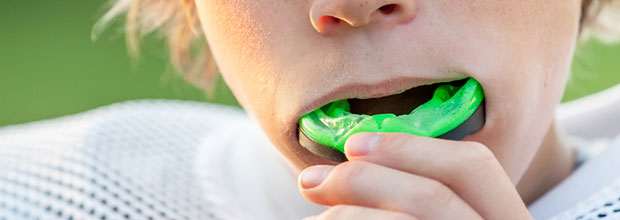With the football season nearing finals time, many players have been wearing their mouthguards week after week. In some cases, players have been wearing their mouthguards week after week for a year… or two. In even scarier cases they aren’t wearing one at all!
This month the Australian Dental Association is celebrating Dental Health Week and is focussed on dental concerns in a sport. A key issue identified by the ADA is the thousands of adults and children being treated for dental injuries that could have been avoided or minimised if they were wearing a properly fitted mouthguard.
As discussed on our Mouthguards page, the ADA has found that only 36% of children use a sports mouthguard, a scary statistic considering how rough children can be and how important teeth are.
Aside from not wearing a mouthguard, damage can come from wearing a worn out, ill-fitting or damaged mouthguard.
Risks with not changing your mouthguard
Sports players who wear a simple “boil and fit” over-the-counter mouthguard will find that the fit isn’t perfect, in these cases a knock to the mouth could cause a tooth to come loose, repositioned to an incorrect place or lost altogether, a risk that becomes heightened when the mouthguard ages and loses its volume.
All mouthguards will slowly become weakened each time pressure is applied to it, a mouthguard that is used for a year, or two, will be significantly weaker than when first fitted. By leaving it too long to replace your mouthguard you can still be placing yourself at risk of dental trauma when your mouthguard doesn’t ‘stack up’ to the impact.
Mouthguards are only supposed to last 6-12 months – When looked after properly!
A little piece of information many people forget – mouthguards aren’t meant to last forever. Most mouthguards have a recommended life of 6-12 months when well looked after. Unless you complete the following, your mouthguard is probably due to replaced (even if it’s only just been 12 months):
- Rinse your mouthguard in cold water after use
- Store it in its provided container (not wrapped in your shorts or stuffed between your strapping tape roll)
- Keep it out of sunlight – high temperatures can cause it to warp
- Rinse it off in mouthwash every so often
- Take your mouthguard with you on your 6-monthly check-ups to make sure it fits correctly
- Replace it as soon as it is damaged!
If you haven’t replaced your mouthguard for a while, or you haven’t been taking care of it, there’s no guarantee it will take care of you.
A new mouthguard is much cheaper and more comfortable than treating a broken or missing tooth!












